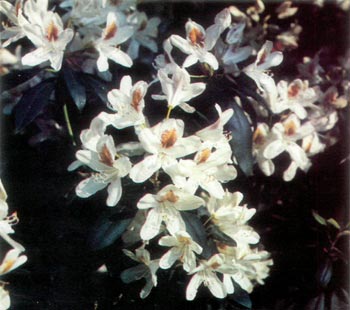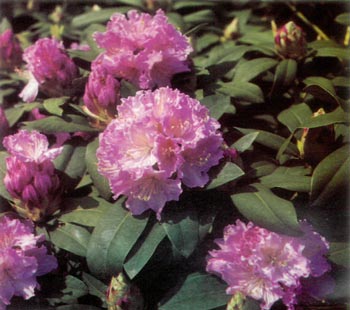Rhododendrons In Czechoslovakia: Czechoslovak Breeding Program
Karel Hieke
The Institute of Ornamental Gardening
Pruhonice, Czechoslovakia
The aims of the Czechoslovak rhododendron breeding program are for frost resistance, ease of propagation, ampleness of flowering, time of flowering, flower composition and size, flower colour, flower colour, habit and leafiness, as well as resistance to disease.
In 1985, we published a survey describing 65 Czechoslovak rhododendron cultivars certified by the State Variety Commission and/or introduced in market.
The Evaluation of the First Stage of the Assortment of Evergreen Large-flower Cultivars of the Genus
Rhododendron
The main comparative experiment was started in 1973 by planting 3 to 4 year plants whose evaluation was performed every year up to the age of 10 years. This experiment included 147 cultivars which were propagated in the same way (grafted onto 'Cunningham's White' rootstock). All experimental plantations were kept without winter coverage. Comparative experiments were performed in November.
Along with the non-stimulated control plants, a combination with 4% and 8% indolyl butyric acid + 1 %, 2% nicotinic acid (talc + orthocid) was used. The experimental plants, planted in the plot in three replications, each of them consisting of 15 plants, were studied in detail as to their morphological and esthetical characters, phenology of flowering and budding, frost hardiness and productivity by cutting.
Out of the total number of 147 studied cultivars, 13 plants were classified as first class (++) and recommended for wide use, 10 plants as very valuable (+) and recommended for the supplementation or substitution for the first class plants. The remaining 124 plants are suitable for growing on a limited scale by rhododendron lovers or dispensable, surpassed and entirely unsuitable for growing.
The plants of the first and second groups were included in the temporary recommended assortment list which will be revised after the evaluation of the following stages using other cultivars.
| Temporary Recommended Assortment List | |
| ++ | 'Antonin Dvorak' (B. Kavka 1969) |
| ++ | 'Blue Peter' (J. Waterer & Crisp 1933) |
| ++ | 'Catawbiense Album' (A. Waterer) |
| + | 'Catawbiense Boursault' (J. Boursault) |
| ++ | 'Catawbiense Grandiflorum' (A. Waterer) |
| ++ | 'Cunningham's White' (G. Cunningham 1850) |
| + | 'Delta' (T.J. Seidel) |
| + | 'Gomer Waterer' (A. Waterer 1900) |
| + | 'Gudrun' (T.J. Seidel 1905) |
| + | 'Humboldt' (T.J. Seidel 1926) |
| + | 'Humoreska' (B. Kavka 1959) |
| ++ | 'Kluis Sensation' (A. Kluis 1946) |
| ++ | 'Lajka' (J. Scholz 1966) |
| ++ | 'Lavender Girl' (W.C. Slocock 1950) |
| ++ | 'Lee's Dark Purple' (M. Lee 1851) |
| ++ | 'Lunik' (J. Scholz 1961) |
| + | 'Madame Masson' (L. Bertin 1849) |
| ++ | 'Milan' (J. Kyndl 1969) |
| ++ | 'Nova Zembla' (D.A. Koster 1902) |
| + | 'Petr' (J. Kyndl 1969) |
| + | 'Purpureum Elegans' (H. Waterer 1850) |
| ++ | 'Roseum Elegans' (A. Waterer 1851) |
| + | 'Von Oheimb Woislowitz' (T.J. Seidel) |

|

|
|
|
'Rose Marie'
Photo by H. Atanasova |
'Antonin Dvorak'
Photo by H. Atanasova |

|

|
|
|
'Lajka'
Photo by H. Atanasova |
'Von Oheimb Woislowitz'
Photo by H. Atanasova |

|

|
|
|
'Multimaculatum'
Photo by H. Atanasova |
'Petr'
Photo by H. Atanasova |